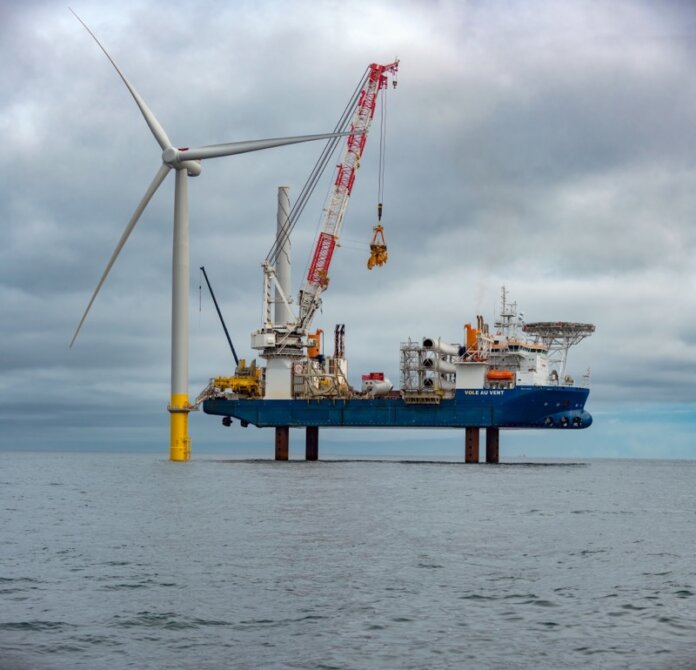Sustainability and resilience are major market drivers reshaping how the power industry views the economics of renewable energy in North America. The influx of renewable solutions – and the need to integrate them with conventional generation, transmission and distribution infrastructure – has changed the dynamics of the power market and introduced incredible new opportunities.
Increasing client demand for energy solutions that balance conventional and renewable generation sources is seen in the world’s growing embrace of offshore wind power as a key component of a more balanced energy mix. In Europe, offshore wind has been in service for more than two decades. Here in the U.S., the market continues to move forward, and offshore wind can be viewed as the next frontier.
In 2018, the American Wind Energy Association (AWEA) announced 2 GW of new offshore wind projects in the U.S. By 2019, that amount had increased tenfold, to 26 GW of planned projects. These new targets indicate the industry is likely at a tipping point.
Currently, there’s only one offshore wind farm operating in the U.S.: Deepwater Wind’s Block Island Wind Farm project. Located off the coast of Rhode Island, the wind farm has five turbines with a total capacity of 30 MW. Our firm designed the onshore interconnection infrastructure: the underground cable that connects the wind farm to the mainland power grid.

Within the U.S., policies are in place to promote offshore wind, particularly as ambitious renewable energy targets bolster offshore wind as one of the next major market areas. Through legislation, goals or executive orders, states are establishing offshore wind procurement targets that range between 21.4 GW and 23.7 GW by 2030. According to AWEA, more than half of those targets – 12.3 GW – were set or increased last year.
With these increasing growth numbers, offshore energy developers are increasingly seeking out leases from the U.S. Department of the Interior’s (DI) Bureau of Ocean Energy Management (BOEM), the federal agency that assesses, identifies and leases areas to developers since most offshore wind development occurs in federal waters. BOEM has awarded 13 commercial wind energy leases off the Atlantic coast, and recently announced two more areas available off the coast of Massachusetts.
The future of offshore wind power looks promising. According to the U.S. Department of Energy’s National Offshore Wind Strategy Report, the U.S. has an offshore wind power potential of more than 4,000 GW – more than four times the generating capacity of the current U.S. electrical system.
Today, more than 10,000 MW of projects are in various stages of development along the Eastern seaboard. Avangrid, in a joint venture with Copenhagen Infrastructure Partners, has the Vineyard Wind project, located 15 miles south of Martha’s Vineyard off the coast of Cape Cod, Mass. Once complete, the project will deliver 800 MW – enough to power more than 400,000 homes across the commonwealth. This team was selected to enter PPA discussions with the Massachusetts and, depending on any further delays, could be operational in the next two to three years.
Offshore wind power is sparking interest in other regions of the country as well. BOEM has identified significant potential along the West Coast, particularly Oregon and California, and interest is also spreading inland, with a 20 MW Lake Erie project currently going through federal approvals.
According to the National Renewable Energy Laboratory (NREL), the global wind industry installed a record 5.6 GW of offshore wind capacity in 2018, resulting in a global cumulative 22 GW of offshore wind capacity installed by the end of 2018. Industry analysts expect this amount to grow six- to eight-fold over the next decade. By 2030, forecasted cumulative offshore global capacity ranges from 140 GW (IHS Markit) to 190 GW (Global Wind Energy Council).
These forecasts demonstrate huge growth trajectories. In the U.S., NREL reports that independent forecasts of America’s growing offshore wind power industry suggest that capacity could grow from 11 GW to 16 GW by 2030. In a recent white paper, the Special Initiative for Offshore Wind (SIOW) projects that wind power could hit 18.6 GW in seven states on the Atlantic Seaboard by 2030. SIOW also projects a nearly $70 billion CAPEX revenue opportunity for businesses in the offshore wind power supply chain over the course of the next decade.
A separate analysis by Norwegian Energy Partners expects global offshore market investment to nearly double in the next five years, from $29 billion in 2019 to $55 billion in 2024. Most of this investment comes from three countries that dominate the global offshore wind market: the United Kingdom, Germany and China, which will account for 90% of global capacity additions this year. But new players such as the U.S., Netherlands and South Korea are making moves to enter the market, and their entrance could reduce the Big Three’s market share to less than half by 2023.
Overcoming challenges
Even though the offshore wind market is full of opportunity, several challenges still need to be addressed and overcome. Federal regulation is a primary concern. BOEM, which manages offshore energy development, slowed the federal offshore wind permitting process in 2019 when it decided that its environmental analysis of Avangrid’s proposed Vineyard Wind I offshore energy project should be expanded into a broader review of the potential impacts of offshore projects.
One issue that prompted BOEM’s delay is concern over the potential impact to the U.S. commercial fishing industry. There is ongoing debate over the various approaches to the science behind environmental and fishery impacts. The U.S. Coast Guard is also conducting a study into possible shipping issues; particularly how wind projects are sited within shipping lanes and safe operating clearances for vessels traveling past turbine towers.
To date, the DI has not publicized a specific scope or timetable, leaving the future approval process uncertain and any type of federal resolution murky. But the industry recently saw some movement when BOEM released a supplement to its draft environmental impact statement (EIS), nearly a year after a final decision was expected.
The supplemental study looks beyond the impacts of Vineyard Wind to address the broader effects of offshore wind on industries, the environment and marine life across the Northeast region. The study found major “adverse” impacts to commercial fishing and scientific research, moderate impacts to marine life, and minor impacts to air quality. The review was published in the Federal Register on June 12, which opens a 45-day public comment period.
Although not encouraging, the study hits on the many issues that will need to be addressed to satisfy the concerns of all stakeholders. Not only is the Vineyard Wind project nowhere close to resolution, but the study’s results introduce uncertainty over how this decision could propagate through other projects, as no one has final approval yet to build offshore wind facilities, and developers continue to face delays on their projects.
Another concern focuses on the substantial increase in energy to the coastal transmission system. Offshore wind could add an enormous amount of power to the existing grid, and the current grid may be unable to handle the influx. Progress has been made in power conditioning, which uses flexible AC transmission to condition the power so it is usable on land, but truly integrating these new renewable power sources will require that new AC grids, offshore substations and subsea export cables be designed, permitted and constructed.
Other issues revolve around the current offshore solicitation model, which gives developers the right to generate power and transmit it onshore. This approach could result in numerous separate transmission lines that serve offshore wind farms, instead of a more centralized system where lines deliver electricity from multiple wind projects. Although that model has become the norm, some states now are discussing whether to separate transmission from generation.
Lastly, NIMBY – not in my backyard – remains an ever-present consideration. These fertile fishing grounds and shoreline areas are expensive real estate, and on land there will always be the risk of community pushback against constructing large, potentially non-native facilities. To mitigate this issue, developers are likely to consider placing the substations inside aesthetically pleasing buildings or within the boundaries of existing infrastructure such as retired power plants.
Partnerships
There’s no doubt that the U.S. wind market is quickly accelerating, and many players are well-positioned to be early adopters and first movers. Selecting the right engineering, procurement and construction (EPC) partner will be critical to the success of these efforts.
Interconnectivity with local utilities will be supremely critical to integrate offshore wind power. These connections are unique to each specific utility’s requirements and existing assets, and the right partner will serve as a conduit between the utility and the energy developers.
When selecting an EPC partner, it will likely be in the developer’s best interest to look for a company that has long-standing relationships with the interconnecting utilities, their preferred subcontractors, and any special requirements of their service territories. These relationships are critical to help facilitate the direct interconnection into existing substations, additions to existing substations, and addition of new substations assets located near existing facilities.
It is also important to select an EPC partner with all the in-house capabilities for comprehensive solutions, including onshore power delivery, submarine cabling, planning, resource assessment and implementation support.
Other considerations include horizontal directional drilling, onshore cable and duct bank design, land-based underground or overhead transmission line design, substation interconnection and substation design, including voltage support requirements in substation designs. All of these skills are likely to be required due to the long cable lengths required to connect to the offshore collector stations.
Preparing for the future
The market potential for North American offshore wind is encouraging, and there is one more game-changer worth mentioning: floating offshore wind. When the underlying technology is ready for commercial expansion, possibly in the next couple years, we will see depth limitations (i.e., requiring shallow ocean depths) be eliminated. There are already plans to use this technology in the Gulf of Maine, the Gulf of Mexico, the California coast and the Oregon Coast, while additional studies are looking at using the technology in the Great Lakes.
At that point, the use of floating technology will be limited only by the availability of continuous wind sources and interconnection constraints, and as such, the opportunity may even dwarf the available lease areas currently under consideration in the Northeast and Mid-Atlantic U.S.
As policies continue to drive offshore wind procurement targets as an addition to the renewable energy mix, the offshore wind industry is truly at a tipping point. But that’s not to say challenges don’t exist: From the regulatory perspective, developers must contend with a measured federal permitting process, ongoing impact studies and uncertain timeframes for approvals. And when it comes to integrating the resulting influx of energy into the power grid, developers may need to construct new facilities to handle the uptick in load, even as the current offshore solicitation model allows for separate lines instead of a more centralized system.
These barriers are daunting, yes, but that’s not to say they are insurmountable. And as regulations continue to evolve – and technology continues to advance – offshore wind power is very likely to be the next major energy frontier in the U.S.
Jim Juras is associate vice president, offshore wind and power solutions, with Black & Veatch’s power business.
Photo: A new 6 MW turbine at the Coastal Virginia Offshore Wind, a collaboration between owner Dominion Energy and contractor Ørsted. Courtesy of Ørsted U.S. Offshore Wind




